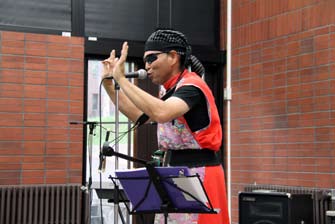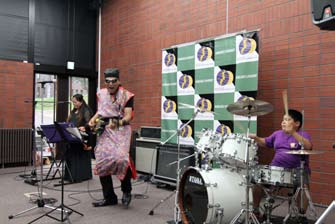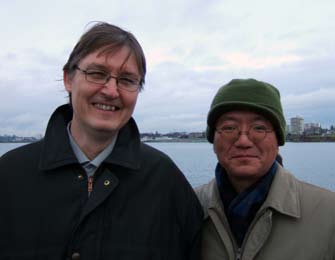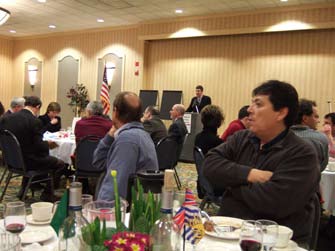| Annual Newsletter of the Slavic Research Center, Hokkaido University |
Japanese English |
-->Annual Newsletter-->no.19 |
|
| No.19, February 2012 | |||
| The Fift h International Symposium of Comparative Research on Major Regional Powers in Eurasia “Alliances and Borders in the Making and Unmaking of Regional Powers” |
| Global COE Program “Reshaping Japan’s Border Studies” | Joint International Symposium “Grammaticalization and Lexicalization in the Slavic Languages” |
| Essay | ||
| IWASHITA Akihiro | ||
How I Was Interwoven into International Borders:
Secret Stories behind the Birth of the Global COE Program “Reshaping Japan’s
Border Studies”
Iwashita Akihiro (SRC)
 |
 |
| Yaeyama Islands: Live performance of Shimanaka Hisahi Family band in Hokkaido University |
I “Vow” in Yonaguni
One of the goals for the Global Center of Excellence (GCOE) Program “Reshaping Japan’s Border Studies” started in October 2009 was to form not an association, but a network engaged in international border studies in Japan. It all started when I was asked to form a “Borderlands Forum” at the Yonaguni Conference of the Japan Society of Island Studies held in September 2007. Along with Yonaguni Mayor Shukichi Hokama, Nemuro Mayor Shunsuke Hasegawa and the then-Tsushima-Mayor Yoshiyuki Matsumura brought up the idea of having a “borderland city summit.” It was good, but almost immediately thereafter I happened to be invited to a think tank in Washington DC, at the Brookings Institution, as a Visiting Fellow.
I work on a first-come, first-served basis to the greatest extent possible ? that is my motto. Therefore, at the end of August, I left my accompanied family behind and headed for Yonaguni via Narita within just two weeks after arriving in Washington. It might sound completely effortless, but I got into trouble after arriving in Narita. What was a tropical cyclone when I left Washington had turned into a typhoon when I arrived at Narita Airport, and it had cancelled all flights to Naha. As soon as I reached Yonaguni via Ishigaki a day behind schedule, the forum had kicked off. The Tsushima Mayor gave up coming to Yonaguni. The Nemuro Mayor was able to dodge the typhoon on his outward journey, but was pursued by the next typhoon on his way back and got stuck in Ishigaki for a whole day. “I thought the weather in Nemuro was harsh, but that of isolated islands is much more severe, isn’t it?” That was a very candid statement by the Nemuro Mayor. Later when arriving in Nemuro in winter, the Yonaguni Mayor had his turn, falling three times on a snowy road and speaking of the severity of the weather in Hokkaido.
On my way home, I was ruminating about the fact that Tsushima Mayor could not make it because of a typhoon. I felt that it must be a voice from heaven that this event should not be ended as a one-time-only show. In October 2008, being lured by the words “the 40th Anniversary of the restoration of the Ogasawara Islands,” I planned to hold a forum in Ogasawara with volunteers from the Japan Society of Island Studies. However, I was newly appointed Director of the Slavic Research Center and had already brought trouble to my colleagues with a 10 month stay in the United States. There was much hesitation about going leaving Sapporo for a week. After all, I gave up my own participation. In the summer of 2009, when I was beginning to think that the next forum would be hosted in Nemuro, we received wonderful news that “Reshaping Japan’s Border Studies” was selected as a Global COE Program. This made our planned “Borderland Forum in Nemuro” larger and larger as an event of the Global COE Program. “Let’s link it to the international symposium for the starting up of the Global COE Program in December. Let’s show the Northern Territories to Western researchers.” Furthermore, we wanted to deliver the fruits of the prior two forums, Japan’s Borders: How to Break the “Spell” (Nihon no Kokkyo: Ikani kono “Jubaku” wo Tokuka) published by Hokkaido University Press in a Slav and Eurasia series, to local people first and foremost at the “Borderland Forum in Nemuro.” Consequently, a book discussion was organized with all the authors. However, because of the snow, it was immediately before the event was to begin when the books were finally delivered from Hokkaido University Press to the hall via a parcel delivery service. The “Borderland Forum in Nemuro” was very exciting with participation by the Yonaguni Mayor, as well as new Tsushima Mayor Yasunari Takarabe and Masaaki Shibuya, a section chief of Ogasawara village. Nonetheless, only the reflection remained that I had turned my fellows around my little finger in the forum: most members of the staff were new to their posts because the Global COE Program had just started. I myself ran about in utter confusion as an inexperienced Director of the Center, and it was a hastily organized event in Nemuro. All I can do is to apologize sincerely to the people who made every effort at the time. My reflection continues. “People come to gather here all the long way, so I want you to enrich the content, not just the event itself.” The words from the enthusiastic Tsushima Mayor shot through me. At the same time, he called for the people to have a forum in Tsushima in the autumn of 2010.
Creating a practical network to connect border regions ? this new assignment was shared with fellow members who had organized forums together and decided to be subsidized by the Sasakawa Peace Foundation. I could not be happier about the development of the project, but the expansion of the operating scale was driving me into a corner. In addition, the venue for the next forum was not Nemuro but Tsushima: far away from Hokkaido. Fortunately I am a person from Kyusyu. I contacted my acquaintances one by one and was finally able to find an excellent partner to handle on-site logistics, Mr. Takayoshi Kabu of the Kyushu Economic Research Center. Mr. Kabu is proficient in Korean and travels between Busan and Fukuoka almost every week. He is a human bridge linking the Japan-Korea strait coastal regions. However, even for such a person like Mr. Kabu, organizing the forum in Tsushima seemed difficult to address in the ordinary way. Thanks to strenuous efforts by Associate Prof. Koji Furukawa of Chukyo University and others, we were able to invite practitioners in charge of cross-border cooperation in municipal governments. The forum was expanded in a regional sense by the participation of Wakkanai, Taketomi, Daito-Jima, Sado, and Oki, in addition to four municipalities (Yonaguni, Ogasawara, Nemuro, and Tsushima) where the forums had taken place. After four municipalities made a round of forums, it seemed sufficient to have a “Borderland Forum” with entertainment tastes. There was a growing tendency to form a practice-based network for international border studies.
However, a new challenge was waiting for me. Being in a good mood after getting through the forum in Tsushima, I called to organize a practical meeting in Yonaguni on a small scale for the preparation of the network. Yonaguni Mayor Hokama, who heard the proposal came back with “Why not make good use of the opportunity? Let’s charter a plane and hold another seminar in Taiwan.” I was thwarted in my plan to hold a compact forum this time around. How many sleepless nights did I spend this year because of the “battle” over the charter flight between Yonaguni and Hualian (although I was able to get better sleep than I was in my office as Director of the Center)? I do not want to recall any of those nights actually. The time is not yet ripe to write about things that happened after that.
Frankly speaking, since teaching at the university, I had never imagined that I would have to do things that a manager of a travel agency would do. However, thinking it through, it might be necessary for me to undertake the role if I wanted to take many people to international border regions because travel firms are a pioneering presence in coordinating border crossings. Although the Global COE Program is often regarded as glamorous at first glance, sober negotiations and persistent efforts through experiencing friction in isolated islands and rural areas are hard things to do and are the opposite of a comfortable city life. Border studies cannot produce results unless we patiently continue to do legwork, such as making rounds of visits to the actual sites or doing unsolicited activities. I have to make time to think one way or another: not by sitting at my desk, but by gathering small pieces of time, such as when sitting in the plane, on the train, or in the driver’s seat of a car, but also when jogging, taking a walk, or when waiting in intervals of a reception. Regrettably for those researchers who come to our Global COE Program in search of classical academism, we would be unable to meet their expectations.
In the course of my busy life, I suddenly remembered that an organization named Japan International Border Studies Network (JIBSN) is to be set up on November 27, 2011.(*1) Looking at it as if it is other people’s business, the appealing phrase is pretty smart and beautiful. They are going to hold a border-crossing seminar next summer as the first project of the network, traversing by regular ferry from Wakkanai to Sakhalin. Voices from Wakkanai reach my ears, “Let’s charter a plane on the way back home.” Until when will my sleepless nights continue?
 |
| BRIT IX reunion on board to the States from Canada |
II “Spell” in Washington
Another goal that the Global COE Program “Reshaping Japan’s Border Studies” set up is to bring international border studies in Eurasia and Eastern Asia together and “sell” them to the world. For that purpose, we invite a European-born research network, Border Regions in Transition (BRIT) to Japan. Having trouble with the Northern Territories issue, it is impossible to host an international border symposium with Russia. On that account, we plan to invite BRIT in Fukuoka and Busan crossing the Tsushima offshore, whose borders are the most stable (clearest) in the areas surrounding Japan. It is aBRIT practice to implement a conference moving between areas across international borders with two countries. With the Berlin Conference of 1994 as the start, the conferences have been held in countries of Europe in turn, but in recent years, they have also been held in North America and South America.(*2) The plan all started with a request made by a professor of Hokkai-Gakuen University. They were going to hold a symposium on the border with Russia in conjunction with the well-known Karelian Institute, University of Joensuu (presently the University of Eastern Finland) in October 2007 and wanted me to report international border issues in Russia, Central Asia, and China. Shortly after I had accepted the request, an invitation was delivered from Washington DC.
As “I work on a first-come, first-served basis to the greatest extent possible” is my motto, one month after moving to Washington, I left my family behind again, incurring their resentment. The then Director was Prof. Ilkka Liikanen of the Karelian Institute. He was one of the presenters at the First Global COE International Symposium of December 2009, and above all, a founding member of BRIT. As soon as he found out that I was in the United States, he called and suggested to that I participate in the Border Regions in Transition IX Conference (Victoria, Canada ? Bellingham, US), which was to take place in the end of January 2008. I am ashamed to say that I did not know about the existence of BRIT at that point. Now I criticize studies of international border issues in Eurasia and East Asia because of its “isolation” from the world and lack of networks with an air of superiority. However, in fact, until a few years ago, I was the very person who should have been the target of my criticism.
For your information, Prof. Liikanen has taken part in all BRIT conferences but one. This surpasses the record of Prof. James Scott, who served as President of ABS (described below) and who was active and based in Berlin as a founding member of BRIT. Probably there is no BRIT medalist who can beat the record of Prof. Liikanen.(*3) The introduction from Prof. Liikanen had an immediate effect. Although the submission of proposals had already been closed long ago, I got myself into the conference as a reporter by force and showed my favorite party piece “Journey through the Eurasian Borders” using slides. It was to introduce the situation in spots through a more than 8000 km field trip crossing the borders from China, Central Asia, and Russia to Japan. I was the only reporter for border issues in the Eurasia region.
In the meantime, as I heard discussions in the BRIT IX conference, I became frustrated. “How peaceful and stable the North American borders are. It is really enviable. Despite that, why do these guys make such a big thing of it saying ‘challenge, challenge’?” Among the discussions, the most controversial one was on the “Smart Border policy” introduced by the United States after September 11. The policy has made it difficult to enter into the United States smoothly from Canada. It was discussed how much economic losses it would cause, and numerous criticisms were raised against the US government. However, I could not find any particular challenge in the custom clearance procedures in Canada and the United States and had no idea what the problem was. While I was confused, a researcher sitting next to me whispered. “It used to take five minutes, but now it takes 30 min. They feel inconvenienced by that.” 30 min! This gave a shock to me, who was reminded of the clearance in the international borders between China and Russia. At this point, I was awakened to the meaning of comparing one border region to another border region. Prof. David Newman of
Ben-Gurion University of the Negev, who knew well about the harshness of border issues in Israel, said to me. “Take these guys to your research field of Eurasia once.” Everybody criticizes policy makers. It is a healthy thing to do. However, there was no researcher from the East Coast, to say nothing of Washington DC, other than Washington state government officials. (I was the only participant from the East. Moreover, I was an alien.) In the Brookings Institution I had begun to realize how people around me were indifferent to international border issues, and thus I could not bear raising my hand at a luncheon session where the topic was heated. “I have been engaged in border studies for many years. It is often difficult to be understood, but in this BRIT conference, there is no need to explain what borders are all about to get started. This makes me delighted and I feel that I finally found the place for me. On the other hand, although I understood your pent-up anger against the US government, there is no one here who is involved in policy making. Even if you raised your voices in a place like this, your thoughts would not be conveyed to them. What channel are you going to use to get them to reflect on policies?” A dead silence fell over the conference hall. People working for Washington State responded that our voices would reach the central government, but we were unable to hear the specific content. After the gathering, someone approached to me. “It’s just as you said.” In this instant, I realized that it was also my mission to “sell” the importance of international border issues to Washington DC and capital cities.
 |
| BRIT IX last day: Greetings from Dr. Emmanuel |
As a practice of BRIT, the method of organizing the next conference is discussed on the final day. Because BRIT is a network and next organizers take over all things pertaining to a next conference, they have no permanent office. It is customary that proposals are received at the final plenary meeting, BRIT organizers in charge at the time discuss them, and the baton is handed over to the next organizers. In the conference in Bellingham, Washington, no one raised their hand to be an organizer in charge of the next conference. Prof. Paul Ganster of San Diego State University, the former BRIT organizer, pressured me saying “You should do it in Japan.” But, I am a newcomer. I am not ready mentally, not to mention ready for preparation. All I could respond with was “after the next.”
The then host of BRIT was Prof. Emmanuel Brunet-Jailly of the University of Victoria. Not only did he strongly support our Global COE Program from the stage of application, but he took part in the First Global COE International Conference and the “Borderlands Forum in Tsushima” of 2010 and offered full support to invite the BRIT XII Conference (Fukuoka- Busan 2012). A chance meeting with him let me know of the existence of Association for Borderlands Studies (ABS) based in North America and rush from Washington DC to the conference in Denver that was set to take place two months later, in April 2008 (The submission of proposals had already been closed, of course.).
Being tossed about by Washington DC and returning to Japan, I received a notice that BRIT X would be held in the international border areas between Chile and Peru of South America in June 2009. I intended to take part in the conference and immediately submitted a report proposal. What was standing in my way was the H1N1 swine flu. At the time,Hokkaido University required a one-week “work suspension” after returning to Japan from “infected areas.” Although I was rather getting used to the job, I could not afford to leave the office of Director of the Center so often.
In the next month, the news was delivered that our program pledged to invite BRIT to Japan was selected by the Global COE. I recall the promise made with Prof. Ganster. On the day when I received the news, the “vow” turned into a “spell” and it has been ruminated on in my dreams. My sleepless nights seem not to end for some time to come.
* The Global Center of Excellence Program is a subsidized project by the Japan Society for the Promotion of Science launched in 2007. The Program will strengthen and enhance the education and research functions of graduate schools in Japan, to foster highly creative young researchers who will go on to become world leaders in their respective fields through experiencing and practicing research of global excellence. The Program will provide funding support for establishing education and research centers that perform at the apex of global excellence to elevate the international competitiveness of Japanese universities. The Global COE Program Committee reviews applications and determines grant selection.(*4)
Notes
- See http://www.borderstudies.jp/jibsn/ (in Japanese). The English information is available soon.
- On the BRIT 2012, see http://www.borderstudies.jp/brit2012/top.html
- For the record of the BRIT, see: http://www.borderstudies.jp/en/publications/review/data/ ebr/2_Liikanen6.pdf On the ABS, see http://www.absborderlands.org/
- See the following homepage of the Global COE Program “Reshaping Japan’s Border Studies” http://www.borderstudies.jp/en/